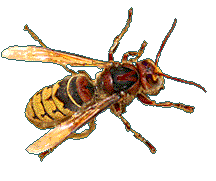 The title here is not the name of an odd law firm or a long-forgotten track by the Rolling Stones, and the bug pictured did not actually sting me...but it all applies to June and July. Welcome to the heart of the hot season around here, with all of the thrills (and very few chills) it brings.
The title here is not the name of an odd law firm or a long-forgotten track by the Rolling Stones, and the bug pictured did not actually sting me...but it all applies to June and July. Welcome to the heart of the hot season around here, with all of the thrills (and very few chills) it brings.We're working through the full-on impact of the mid-Summer beekeeping season around here, with all six colonies jammed full of bees and honey and the sun at full strength on the back of my veil. Going out to the beehives in the July sun is a lesson about success: the families are bustling and the harvest is sweet, but the boxes are heavy and the bees are more easily riled. No complaints, though: for the second year in a row, we will have a harvest, and the workout required has pared off a few pounds.
Sticky
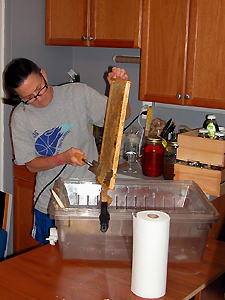 Since the nectar flow ended over a month ago, the harvest season is upon us (you might say it is all over us, too – as well as the floors, the counters and the dogs). That's the sticky part of all this. In late June, MaryEllen and I got together with Jane to help the latter harvest honey for the first time. Some of the usual panic ensued: "How do I get my honey frames out of the hive?!" But Jane worked it out – in this case, by using an approach more common in Europe. You can remove a limited amount of honey by reaching in, grabbing one frame at a time, walking away and shaking the bees off ,then brushing the remainder gently away and stowing the now bee-free frame in a covered box. This is good for only a few frames, because after a bunch of shaking the bees get Quite Unhappy. Jane cleared two boxes, and took home 5 gallons of honey! I pulled only 9 frames from the roof, and was pleased to get a bit more than two gallons of very light honey. I think it's a mostly-linden year!
Since the nectar flow ended over a month ago, the harvest season is upon us (you might say it is all over us, too – as well as the floors, the counters and the dogs). That's the sticky part of all this. In late June, MaryEllen and I got together with Jane to help the latter harvest honey for the first time. Some of the usual panic ensued: "How do I get my honey frames out of the hive?!" But Jane worked it out – in this case, by using an approach more common in Europe. You can remove a limited amount of honey by reaching in, grabbing one frame at a time, walking away and shaking the bees off ,then brushing the remainder gently away and stowing the now bee-free frame in a covered box. This is good for only a few frames, because after a bunch of shaking the bees get Quite Unhappy. Jane cleared two boxes, and took home 5 gallons of honey! I pulled only 9 frames from the roof, and was pleased to get a bit more than two gallons of very light honey. I think it's a mostly-linden year!Stingy
We've also had very little rain, 4 inches less than usual, and it feels like our usual Summer dearth season may come early. Things that annoy honeybees are coming from out of the woodwork (and the woods), all contributing to an increased risk of getting a sting (or 5). I don't usually get stung when working the hives, and I'm still working with gloves off for the most part. I have pushed the limits from time to time, though – like using the frame removal method above with an already-riled hive! It's time to take experienced beekeepers' advice and try to work hives at the cool beginnings of sunny days, to work efficiently but slowly, and to work only when there is a good reason to be there. We're coming upon the days when we will just do mite checks and feed sugar syrup.
Woozy
I got first-time experience with an unanticipated physical reaction to a honeybee sting (and so did Andrea!) when a first-time apiary visitor got stung while visiting the Monastery hives on Wednesday (Happy Fourth of July!) Andrea, someone with an excellent dog whom I know from frequenting a local park, knows that she is not allergic to bee sting, but got dizzy and passed out a couple of minutes after she got a sting on the hand. At first all seemed well: Joseph (one of the new beekeepers there) and I smeared our anti-sting ointment on the injury, and Andrea continued looking on. Then she said she was light-headed, and passed out briefly after we got her sitting down. Holy smokes! It was not an allergic reaction (was it heat? adrenalin? cosmic rays?), but something took her down. She was beyond cool, not freaking out at all, but it reminds me to be more serious and more careful when inviting people to experience bees first hand. Nature tells me over and over again that I am wrong when I get to thinking I've got everything under control.
Dead
Recently the Monastery's hives have been downright "spicy:" calm enough to be around, but easy to rile when the boxes are opened. This can be for any number of reasons – a clumsy beekeeper, dearth in the nectar supply, queen genetics, or constant threats from natural predators. The queens come from different sources, but I have seen giant hornets circling in front of the hives, and I think the latter may be the culprits.
When the bees are attacked, even by another bug like a hornet, the guard bees send out a near-constant stream of alarm pheromone, making them primed to see threats even before the beekeeper approaches. If nectar is drying up, like it has been around here, there are even more forager bees hanging around the hive with nothing to do (except, perhaps, respond to perceived threats). Now, the hornet picture I put at the very beginning of this post is meant to express just how threatening just that one predator can seem, even to a person. Online, scared enquirers have called European Giant Hornets (Vespa crabro) "School Bus Bees" (though they ARE NOT bees) and you can see why in person. The graphic is about life size: almost 1.5 inches or 3.5 centimeters. They kind of take your breath away when you first seem them.
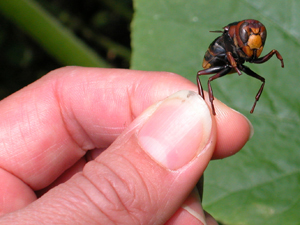 But the "Dead" in today's title refers to an impressive hornet specimen found on the bottom of the Clare hive right after Andrea keeled over and was driven home. Though the hornet is easily twice the size of the worker bees, they nonetheless have a group defense against the interlopers. In this case, the presence of most of a hornet carcass confirms that the hives have been under regular attack, and have been defending themselves vigorously. The hornet is too big for the undertaker bees to move, so they have been chewing pieces off and disposing of them. Her abdomen, wings, and antennae are almost completely gone.
But the "Dead" in today's title refers to an impressive hornet specimen found on the bottom of the Clare hive right after Andrea keeled over and was driven home. Though the hornet is easily twice the size of the worker bees, they nonetheless have a group defense against the interlopers. In this case, the presence of most of a hornet carcass confirms that the hives have been under regular attack, and have been defending themselves vigorously. The hornet is too big for the undertaker bees to move, so they have been chewing pieces off and disposing of them. Her abdomen, wings, and antennae are almost completely gone. 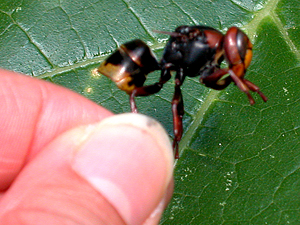 Even though we are thousands of times the size of such a creature, we humans often feel a great thud in the middle of our chests when we confront these beasts. When I was holding the hornet bits to try to get a photo for you, I could hear the distant "Ewwww!" of some frightened multitudes in the back of my mind, but the revulsion must be paired with an unescapable attraction, or why would our Porsches and muscle-car marauders choose to look so much the same?
Even though we are thousands of times the size of such a creature, we humans often feel a great thud in the middle of our chests when we confront these beasts. When I was holding the hornet bits to try to get a photo for you, I could hear the distant "Ewwww!" of some frightened multitudes in the back of my mind, but the revulsion must be paired with an unescapable attraction, or why would our Porsches and muscle-car marauders choose to look so much the same?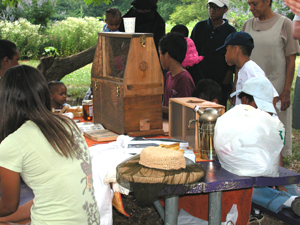 Finally, I want you to know that June 24-30 was the first National Pollinator Week here in the United States, and in various combinations MaryEllen and I gave more than 8 hours of presentations at historic sites and community gardens. A thoroughly exhausting blast! Have (borrowed) observation hive, will travel. This summer has a number of summer camps in it, as well as a county and a state fair, so the fun won't stop soon.
Finally, I want you to know that June 24-30 was the first National Pollinator Week here in the United States, and in various combinations MaryEllen and I gave more than 8 hours of presentations at historic sites and community gardens. A thoroughly exhausting blast! Have (borrowed) observation hive, will travel. This summer has a number of summer camps in it, as well as a county and a state fair, so the fun won't stop soon.
3 comments:
http://benliaricilik.blogspot.com/2007_01_01_archive.html
Bhe comment above is from a turkish beekeeper -- if you follow his link WAY down the page, you will come to a video of honeybees attacking a giant hornet. This is a very cool contribution, Benli Zeytincilik! Thank you!
Thank you very much! Your blog is very interesting. I will add your blog to my links list. İf you add my blog to yours. I will be happy.
Thanks...
Post a Comment